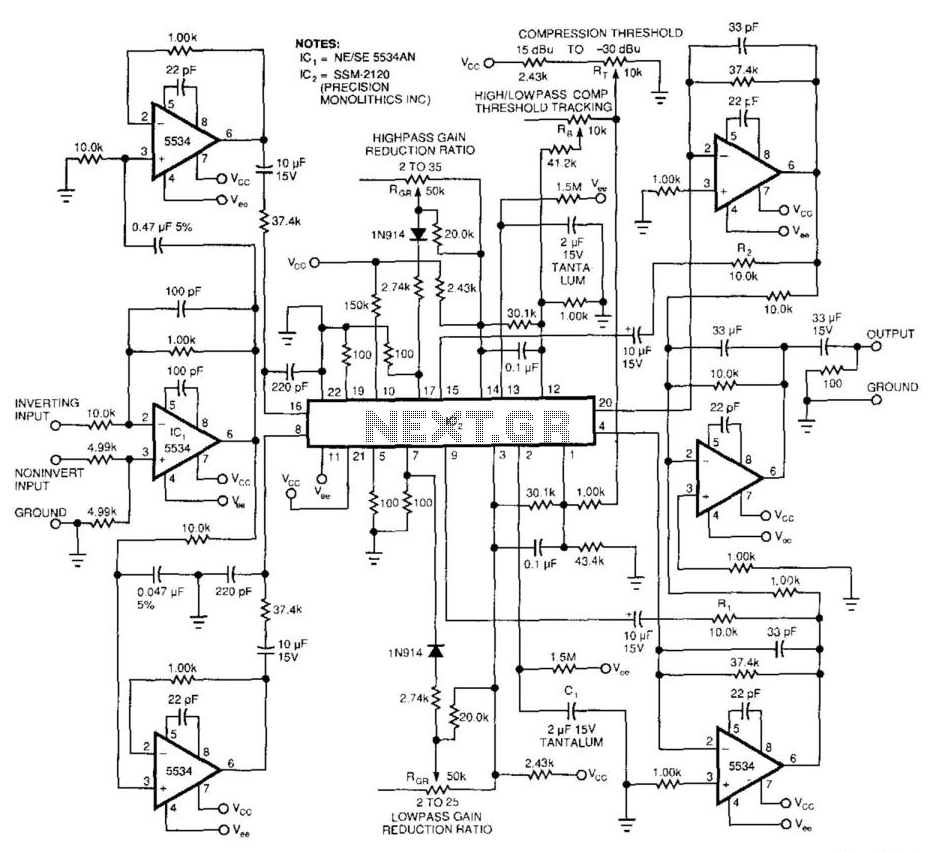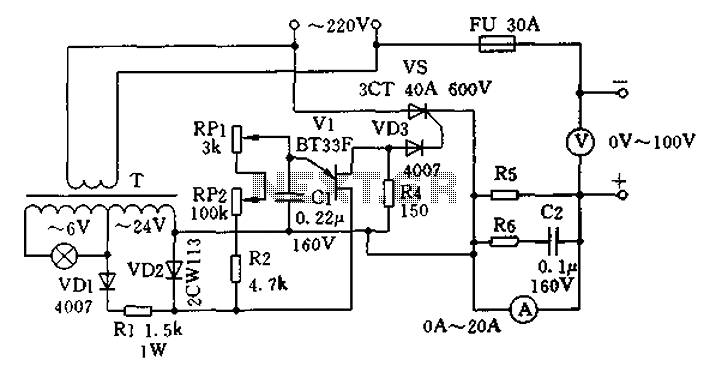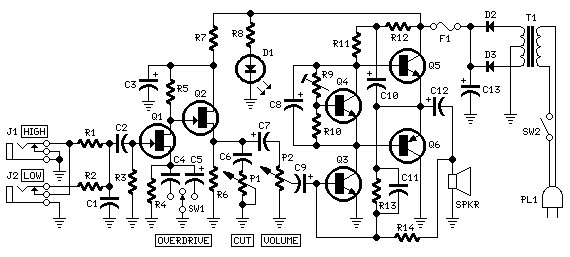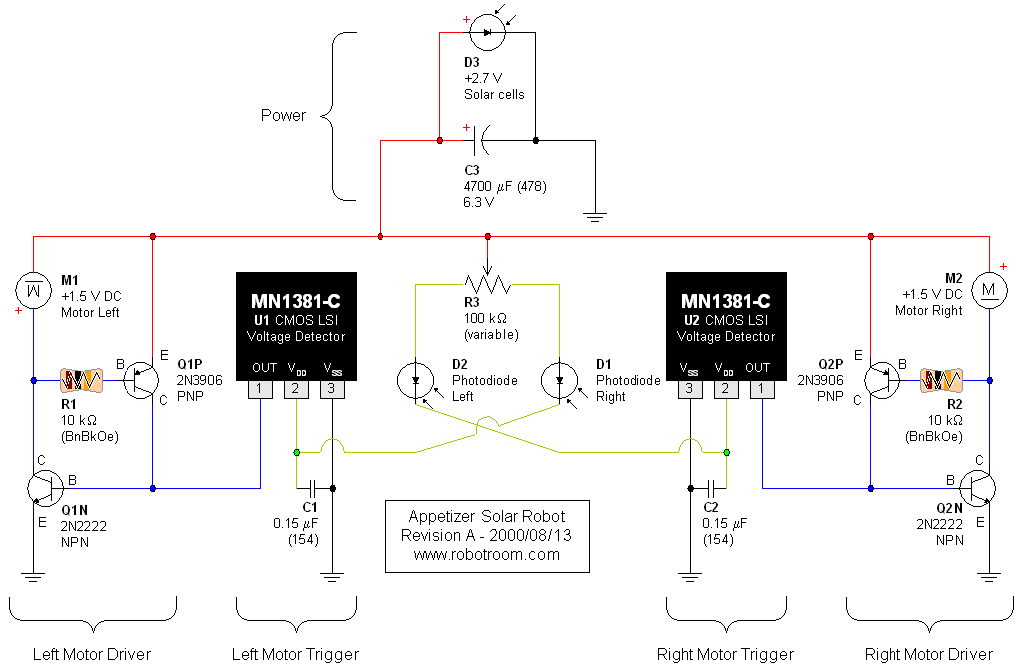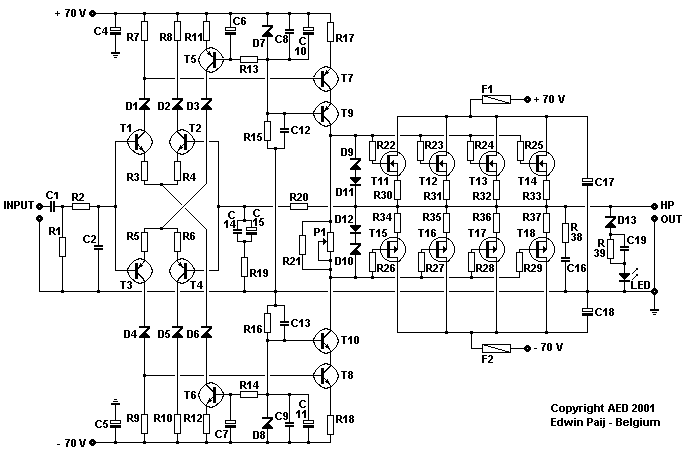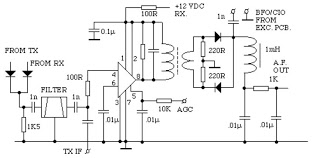
Audio power Amplifier Tester Dummy load
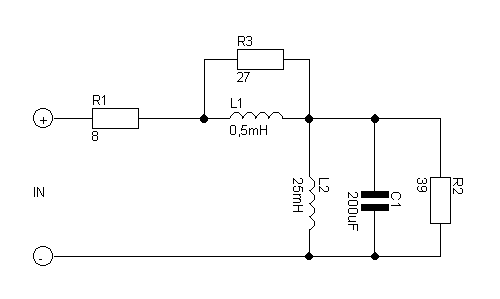
If you want to test an amplifier, a dummy load may be more convenient for speakers to use than actual speakers, due to noise or damage to the speakers. This circuit behaves in terms of impedance and frequency response as a real speaker and is calculated for a power of 100 watts into 8 ohms. The value of 4 ohms is shown in parentheses. More: Parts List R1 = 8 ohms (4 ohms) 100 watts R2 = 39 ohm (18 ohm) 5 Watt R3 = 27 ohms (12 ohm) 5 Watt C1 = 200uF (400uF) bipolar Elko L1 = 0.5 mH (0.25 mH) 3A Triac / mains suppressor L2 = 25 mH (12 mH) 3A Triac / mains suppressor
The described circuit functions as a dummy load for testing audio amplifiers. It is designed to simulate the electrical characteristics of a real speaker, thereby allowing for safe testing without risking damage to actual speaker components. The primary load resistor, R1, is rated at 8 ohms, which is a standard impedance value for many speakers, and is capable of handling up to 100 watts of power. An alternative value of 4 ohms is noted in parentheses, indicating that the circuit can also be configured to test amplifiers designed for lower impedance loads.
The circuit includes additional resistors, R2 and R3, which serve to modify the overall impedance and frequency response. R2 is specified as 39 ohms (with a secondary value of 18 ohms), rated for 5 watts, while R3 is 27 ohms (with a secondary value of 12 ohms), also rated for 5 watts. These resistors can help in fine-tuning the load characteristics to better match various amplifier designs.
Capacitance is provided by C1, a bipolar electrolytic capacitor rated at 200 microfarads, with a higher value of 400 microfarads listed in parentheses. This capacitor plays a crucial role in shaping the frequency response of the dummy load, allowing it to emulate the reactive nature of a real speaker.
Inductors L1 and L2 are included as part of the circuit to further refine the load characteristics. L1, with an inductance of 0.5 mH (or 0.25 mH), is rated for 3A and functions as a mains suppressor, helping to filter out high-frequency noise that could affect amplifier performance. L2, having an inductance of 25 mH (or 12 mH), also rated for 3A, serves a similar purpose, ensuring that the dummy load remains stable under various operating conditions.
This combination of resistive, capacitive, and inductive components allows the dummy load circuit to closely mimic the behavior of a real speaker, providing a safe and effective means of testing audio amplifiers without the risks associated with using actual speaker units.If you want to test an amplifier may be a dummy sometimes convenient for speakers to use than the actual speakers, due to noise or damage to the speakers. This circuit behaves in terms of impedance and frequency response as a real speaker and is calculated for a power of 100 watts into 8 ohms.
The value of 4 ohms is shown in parentheses. Parts List R1 = 8 ohms (4 ohms) 100 watts R2 = 39 ohm (18 ohm) 5 Watt R3 = 27 ohms (12 ohm) 5 Watt C1 = 200uF (400uF) bipolar Elko L1 = 0.5 mH (0.25 mH) 3A Triac / mains suppressor L2 = 25 mH (12 mH) 3A Triac / mains suppressor 🔗 External reference
The described circuit functions as a dummy load for testing audio amplifiers. It is designed to simulate the electrical characteristics of a real speaker, thereby allowing for safe testing without risking damage to actual speaker components. The primary load resistor, R1, is rated at 8 ohms, which is a standard impedance value for many speakers, and is capable of handling up to 100 watts of power. An alternative value of 4 ohms is noted in parentheses, indicating that the circuit can also be configured to test amplifiers designed for lower impedance loads.
The circuit includes additional resistors, R2 and R3, which serve to modify the overall impedance and frequency response. R2 is specified as 39 ohms (with a secondary value of 18 ohms), rated for 5 watts, while R3 is 27 ohms (with a secondary value of 12 ohms), also rated for 5 watts. These resistors can help in fine-tuning the load characteristics to better match various amplifier designs.
Capacitance is provided by C1, a bipolar electrolytic capacitor rated at 200 microfarads, with a higher value of 400 microfarads listed in parentheses. This capacitor plays a crucial role in shaping the frequency response of the dummy load, allowing it to emulate the reactive nature of a real speaker.
Inductors L1 and L2 are included as part of the circuit to further refine the load characteristics. L1, with an inductance of 0.5 mH (or 0.25 mH), is rated for 3A and functions as a mains suppressor, helping to filter out high-frequency noise that could affect amplifier performance. L2, having an inductance of 25 mH (or 12 mH), also rated for 3A, serves a similar purpose, ensuring that the dummy load remains stable under various operating conditions.
This combination of resistive, capacitive, and inductive components allows the dummy load circuit to closely mimic the behavior of a real speaker, providing a safe and effective means of testing audio amplifiers without the risks associated with using actual speaker units.If you want to test an amplifier may be a dummy sometimes convenient for speakers to use than the actual speakers, due to noise or damage to the speakers. This circuit behaves in terms of impedance and frequency response as a real speaker and is calculated for a power of 100 watts into 8 ohms.
The value of 4 ohms is shown in parentheses. Parts List R1 = 8 ohms (4 ohms) 100 watts R2 = 39 ohm (18 ohm) 5 Watt R3 = 27 ohms (12 ohm) 5 Watt C1 = 200uF (400uF) bipolar Elko L1 = 0.5 mH (0.25 mH) 3A Triac / mains suppressor L2 = 25 mH (12 mH) 3A Triac / mains suppressor 🔗 External reference
Warning: include(partials/cookie-banner.php): Failed to open stream: Permission denied in /var/www/html/nextgr/view-circuit.php on line 713
Warning: include(): Failed opening 'partials/cookie-banner.php' for inclusion (include_path='.:/usr/share/php') in /var/www/html/nextgr/view-circuit.php on line 713
